A New Methodology for the Development of Appropriate Technology: A Case Study for the Development of a Wood Solar Dryer
Abstract
1. Introduction
2. Methodology for the Development of Appropriate Technology
3. Case-Study
3.1. Target Community and Consumption Diagnosis
3.1.1. Diagnosis of Consumption of Natural Resources for the Construction of Furniture
3.1.2. Review of Technological Devices (Stage 2)
3.2. Technology Development
3.2.1. Technology Proposal: Selection of the Device Features (Stage 3)
- (i)
- Constant temperature:T = 1 on bottom wall, T = 0 on top wall
- (ii)
- thermal insulation:
- (iii)
- and the no-slip condition for the velocity:
3.2.2. Technology Considerations of the Device (Stage 4)
3.2.3. Life-Cycle Assessment of the Technology Device (Stage 5)
3.2.4. General Design of the Technology Device (Stage 6)
3.2.5. Construction of the Wood Solar Dryer (Stage 7)
3.2.6. Functional Characterization of the Technology Device (Stage 8)
4. Summary and Conclusions
- Three geometries of a solar wood-dryer prototype were proposed and analyzed with the computer software Open FOAM [42]. All proposed geometries showed better interior heat transfer than the traditional wood-brick dryer.
- A Life-Cycle Analysis (LCA) of the proposed solar wood-dryer was carried out as part of the methodology. The results showed that the new solar wood-dryer prototype has environmental impacts in all analyzed categories that are 5% or smaller than those of the traditional dryer. Particularly, global warming potential figures decreased by about 98% with the use of the proposed solar wood-dryer. Due to the aim of this study was to compare our proposed solar wood-dryer with the traditional dryer it was immediately displacing, we omitted comparisons with other devices in the market.
- Based on the designed geometries, the LCA, and the considerations proposed by the artisans of the community, a solar wood-dryer was developed which has 20% efficiency. The design, construction, and energy evaluation of this device, incorporated the technical and operational requirements requested by the artisans in the community.
- The functionality of the solar wood-dryer was checked to meet an identified need based on a diagnosis of consumption of timber resources. The dryer met the purpose for which it was designed, and it will be delivered to artisans for frequent use.
- It was identified that the accompaniment of artisans during all stages of the methodology was essential to facilitate the construction and functionality evaluation. The information that they provided at each stage represented an exercise in co-design and technology development that covered their needs and motivated its possible adoption. Therefore, it should be noted that accompaniment is a key factor since we believe that technology should always suits the user and not vice versa. Finally, it is envisioned that the systematic way of developing appropriate technology should be energy efficient, socially acceptable, and economic and environmentally viable as suggested in this methodology.
Author Contributions
Funding
Acknowledgments
Conflicts of Interest
References
- Muhumuza, R.; Zacharopoulos, A.; Mondol, J.D.; Smyth, M.; Pugsley, A. Energy consumption levels and technical approaches for supporting development of alternative energy technologies for rural sectors of developing countries. Renew. Sustain. Energy Rev. 2018, 97, 90–102. [Google Scholar] [CrossRef]
- Green, D. Cross cultural technology transfer of sustainable energy systems: A critical analysis. Renew. Energy 1999, 16, 1133–1137. [Google Scholar] [CrossRef]
- Luthra, S.; Kumar, S.; Garg, D.; Haleem, A. Barriers to renewable/sustainable energy technologies adoption: Indian perspective. Renew. Sustain. Energy Rev. 2015, 41, 762–776. [Google Scholar] [CrossRef]
- Vaccari, M.; Vitali, F.; Mazzù, A. Improved cookstove as an appropriate technology for the Logone Valley (Chad-Cameroon): Analysis of fuel and cost savings. Renew. Energy 2012, 47, 45–54. [Google Scholar] [CrossRef]
- Víquez, S. Biogas as an alternative energy source to promote indigenous communities development. Manag. Econ. Eng. Agric. Rural Dev. 2013, 13, 345–352. [Google Scholar]
- Wilson, M.; Green, J.M. The feasibility of introducing solar ovens to rural women in Maphephethe. Tydskrif vir Gesinsekologie en Verbruikers Wetenskappe 2000, 28, 54–61. [Google Scholar] [CrossRef]
- González-Avilés, M.; López-Sosa, L.B.; Sernvín-Campuzano, H.; González-Pérez, D. Adoption sustainable technology of solar cookers in indigenous and rural communities of Michoacán. Rev. Mex. Ing. Química 2017, 16, 273–282. [Google Scholar]
- Patnaik, J.; Bhowmick, B. Revisiting appropriate technology with changing socio-technical landscape in emerging countries. Technol. Soc. 2019, 57, 8–19. [Google Scholar] [CrossRef]
- Thomas, H. De las Tecnologías Apropiadas a las Tecnologías Sociales. Conceptos/Estrategias/Diseños/Acciones; Programa Consejo de la Demanda de Actores Sociales-Ministerio de Ciencia, Tecnología e Inno: Buenos Aires, Argentina, 2009. [Google Scholar]
- Ruiz-Mercado, I.; Masera, O.; Zamora, H.; Smith, K.R. Adoption and sustained use of improved cookstoves. Energy Policy 2011, 39, 7557–7566. [Google Scholar] [CrossRef]
- Hossain, M. Grassroots innovation: A systematic review of two decades of research. J. Clean. Prod. 2016, 137, 973–981. [Google Scholar] [CrossRef]
- MacCarty, N.A.; Bryden, K.M. An integrated systems model for energy services in rural developing communities. Energy 2016, 113, 536–557. [Google Scholar] [CrossRef]
- Sianipar, C.P.M.; Dowaki, K.; Yudoko, G. Technological solution for vulnerable communities: Questioning the sustainability of appropriate technology. In Proceedings of the IOP Conference Series: Earth and Environmental Science, Bali, Indonesia, 11–12 October 2015; IOP Publishing Ltd.: Bristol, UK; Volume 23. [Google Scholar]
- Alvarez-Castañon, C.; Tagle-Zamora, D.; Romero-Ugalde, M. Transference of Ecotechnology in Disadvantaged Regions of Mexico, Towards Sustainable Development. In Sustainable Development Research and Practice in Mexico and Selected Latin American Countries; Leal Filho, W., Noyola-Cherpitel, R., Medellín-Milán, P., Vargas, V.R., Eds.; Springer: Berlin/Heidelberg, Germany, 2018; pp. 139–152. [Google Scholar]
- López-Sosa, B.; Bernardo, L.; Gonzalez-Aviles, M.; Servín, H. Ecotécnias y Tecnologías Solares Térmicas: Proyecto de implementación tecnológica en el sector rural Michoacano. Revista en Energías Renovables. Rev. Energías Renov. Asoc. Nac. Energía Solar. 2016, 17, 30–33. [Google Scholar]
- Rodríguez Morales, J.Á. Diagnóstico, Desarrollo, Implementación y Monitoreo de un Sistema de Cocción Solar Multiuso en Comunidades Rurales de Michoacán, México. Master’s Thesis, Universidad Politécnica de Cataluña, Barcelona, España, 2017. [Google Scholar]
- Berrueta, V.M.; Serrano-Medrano, M.; García-Bustamante, C.; Astier, M.; Masera, O.R. Promoting sustainable local development of rural communities and mitigating climate change: The case of Mexico’s Patsari improved cookstove project. Clim. Chang. 2017, 140, 63–77. [Google Scholar] [CrossRef]
- Ruiz-Mercado, I.; Masera, O. Patterns of stove use in the context of fuel-device stacking: Rationale and implications. Ecohealth 2015, 12, 42–56. [Google Scholar] [CrossRef] [PubMed]
- Álvarez-Castañón, C.; Tagle-Zamora, D. Transferencia de ecotecnologías y su adopción social en localidades vulnerables: Una metodología para valorar su viabilidad. CienciaUAT 2019, 13, 21–30. [Google Scholar] [CrossRef]
- Choi, H.J. Technology Transfer Issues and a New Technology Transfer Model. J. Technol. Stud. 2009, 35, 49–57. [Google Scholar] [CrossRef]
- Rockström, J.; Steffen, W.; Noone, K.; Persson, Å.; Chapin, S.F., III; Lambin, E.F.; Lenton, T.M.; Scheffer, M.; Folke, C.; Schellnhuber, H.J.; et al. A safe operating space for humanity. Nature 2009, 461, 472–475. [Google Scholar] [CrossRef] [PubMed]
- Karunathilake, H.; Hewage, K.; Mérida, W.; Sadiq, R. Renewable energy selection for net-zero energy communities: Life cycle based decision making under uncertainty. Renew. Energy 2019, 130, 558–573. [Google Scholar] [CrossRef]
- Kirchain, R.E.; Gregory, J.R.; Olivetti, E.A. Environmental Life-Cycle Assessment. Nat. Mater. 2017, 16, 693–697. [Google Scholar] [CrossRef] [PubMed]
- Gerber, L. Designing Renewable Energy Systems. A Life Cycle Assessment Approach; EPFL Press: Laussane, Switzerland, 2014. [Google Scholar]
- Salazar, M.C. La Investigación-Acción Participativa: Inicios y Desarrollos; Organización de Estados Iberoamericanos para la Educación, la Ciencia y la Cultura: Sociedad Estatal Quinto Centenario: Quito, Ecuador, 1992. [Google Scholar]
- Assefa, G.; Frostell, B. Social sustainability and social acceptance in technology assessment: A case study of energy technologies. Technol. Soc. 2007, 29, 63–78. [Google Scholar] [CrossRef]
- Jollands, N.; Harmsworth, G. Participation of indigenous groups in sustainable development monitoring: Rationale and examples from New Zealand. Ecol. Econ. 2007, 62, 716–726. [Google Scholar] [CrossRef]
- Gavito, M.E.; van der Wal, H.; Aldasoro, E.M.; Ayala-Orozco, B.; Bullén, A.A.; Cach-Pérez, M.; Casas-Fernández, A.; Fuentes, A.; González-Esquivel, C.; Jaramillo-López, P.; et al. Ecología, tecnología e innovación para la sustentabilidad: Retos y perspectivas en México. Rev. Mex. Biodivers. 2017, 88, 150–160. [Google Scholar] [CrossRef]
- Sianipar, C.P.M.; Yudoko, G.; Dowaki, K.; Adhiutama, A. Design methodology for appropriate technology: Engineering as if people mattered. Sustainability 2013, 5, 3382–3425. [Google Scholar] [CrossRef]
- Dassault Systemes SolidWorks. Available online: https://www.solidworks.com/es (accessed on 7 August 2018).
- Sianipar, C.P.M.; Yudoko, G.; Dowaki, K. Materials research in appropriate technology: In the midst of science, engineering, and technology. Key Eng. Mater. 2014, 594–595, 334–338. [Google Scholar] [CrossRef]
- ISO. ISO Norm 14040:2006 and 140444:2006. Life Cycle Assessment: Principles and Framework; Environmental Management; International Organization for Standardization, 2006; Available online: https://www.iso.org/obp/ui/#iso:std:iso:14040:ed-2:v1:en (accessed on 18 September 2018).
- Salas Garita, C.; Moya Roque, R.; Córdoba Foglia, R. Diseño y construcción de un secador solar para madera. Rev. For. 2008, 5, 1–24. [Google Scholar]
- Moreno, G. Manual de Construcción y Operación de Una Secadora Solar, Seminario de Proyectos ll, Ing. en Energía; Universidad Autónoma Metropolitana-I: Ciudad de México, México, 2006. [Google Scholar]
- Benítez, R.; Calderón, A. Secador Solar Para Madera; Cemapif—Cuprofor: Siguatepeque, Honduras, 1993. [Google Scholar]
- Pozos-Suárez, I. Diseño Térmico Para un Horno Solar de Secado de Madera; Universidad Veracruzana: Xalapa, México, 2010. [Google Scholar]
- Nawshadul, H.M. Performance of an Industrial Solar Kiln for Drying Timber. Dry. Technol. 2005, 23, 1541–1553. [Google Scholar]
- Ignacio, F. Diseño de un Secador Híbrido Para Madera Aserrada; Instituto Politécnico Nacional: Santa Cruz Xoxocotlán, México, 2008. [Google Scholar]
- Reuss, M.; Benkert, S.; Aeberhard, A.; Martina, P.; Raush, G.; Rentzell, B.V.; Sogari, N. Modelling and experimental investigation of a pilot plant for solar wood drying. Sol. Energy 1997, 59, 259–270. [Google Scholar] [CrossRef]
- Martínez-Pinillos Cueto, E. Diseño y ensayo de un secador solar para madera. Madera y Bosques 1997, 3, 13–28. [Google Scholar] [CrossRef][Green Version]
- Fuentes-Salinas, M.; Luna-Sánchez, D.; Osorio-Suárez, J.; Corona-Islas, J. Construcción y validación de un secador solar para madera aserrada. Revista Chapingo Serie Ciencias Forestales y del Ambiente 2003, 9, 171–176. [Google Scholar]
- Open FOAM Fundation 2012. Available online: https://www.openfoam.com (accessed on 15 October 2018).
- Nuñez, J.; Beltrán, A. On the onset of natural convection in a partially cooled cylinder. Heat Transf. Res. 2018, 49, 773–786. [Google Scholar] [CrossRef]
- White, F.M. Fluid Mechanics; McGraw-Hill: New York, NY, USA, 2008. [Google Scholar]
- Database Ecoinvent 3.5. Available online: https://www.ecoinvent.org (accessed on 20 September 2018).
- Fudholi, A.; Sopian, K.; Ruslan, M.H.; Alghoul, M.A.; Sulaiman, M.Y. Review of solar dryers for agricultural and marine products. Renew. Sustain. Energy Rev. 2010, 14, 1–30. [Google Scholar] [CrossRef]
- López-Sosa, L.B.; Hernández-Ramírez, L.M.; González-Avilés, M.; Servín-Campuzano, H.; Zárate-Medina, J. Desarrollo de un recubrimiento absorbente solar de bajo costo basado en hollín de biomasa forestal: Caracterización térmica y aplicación en un sistema de cocción solar. Revista Mexicana de Ingeniería Química 2018, 17, 651–668. [Google Scholar] [CrossRef]
- Ruiz-Mercado, I.; Canuz, E.; Walker, J.L.; Smith, K.R. Quantitative metrics of stove adoption using Stove Use Monitors (SUMs). Biomass Bioenergy 2013, 57, 136–148. [Google Scholar] [CrossRef] [PubMed]
- Chavan, B.R.; Yakupitiyage, A.; Kumar, S. Drying performance, quality characteristics, and financial evaluation of Indian Mackerel (Rastrilliger kangurta) dried by a solar tunnel dryer. Thammasat Int. J. Sci. Technol. 2011, 2, 11–25. [Google Scholar]
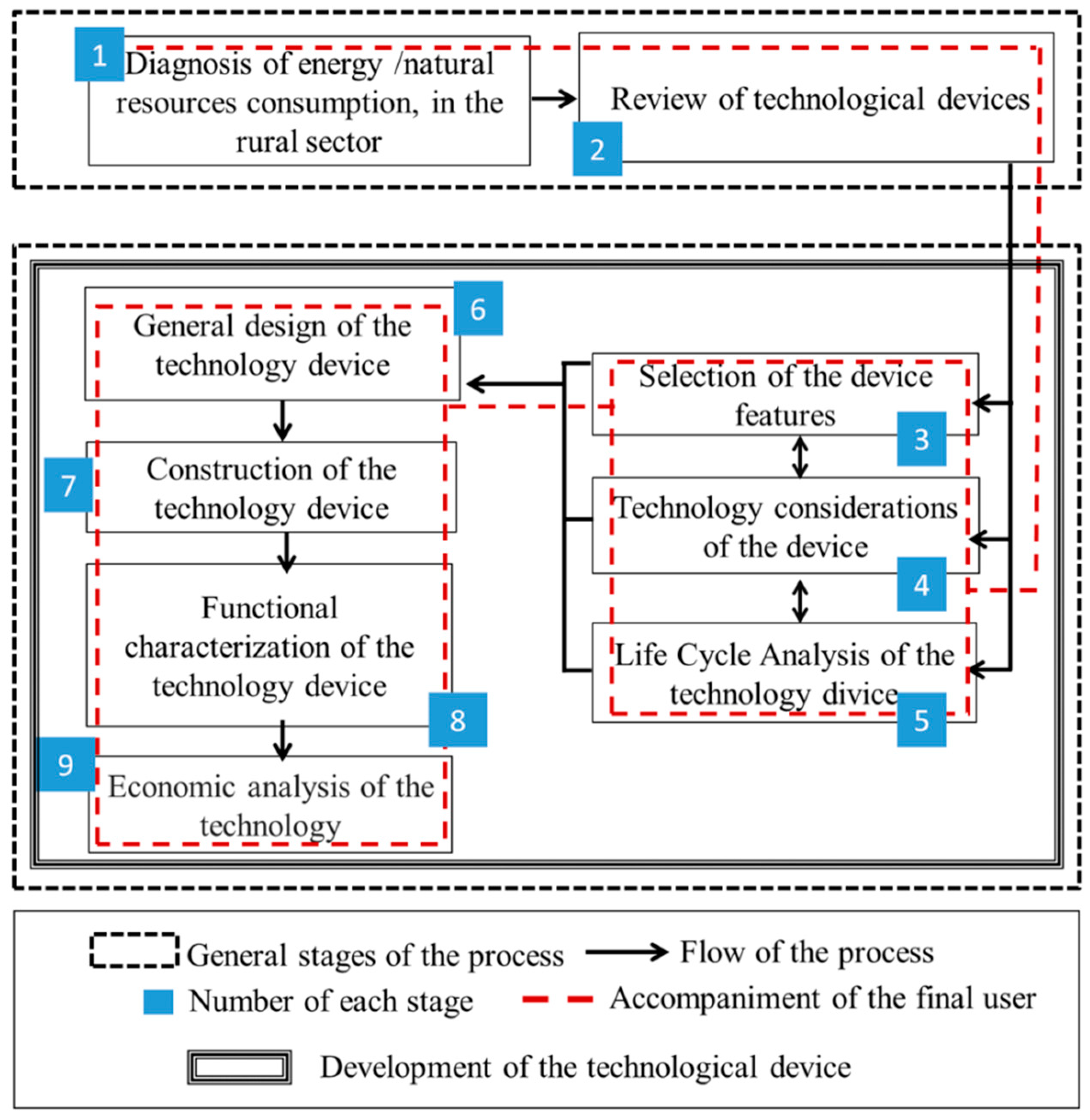
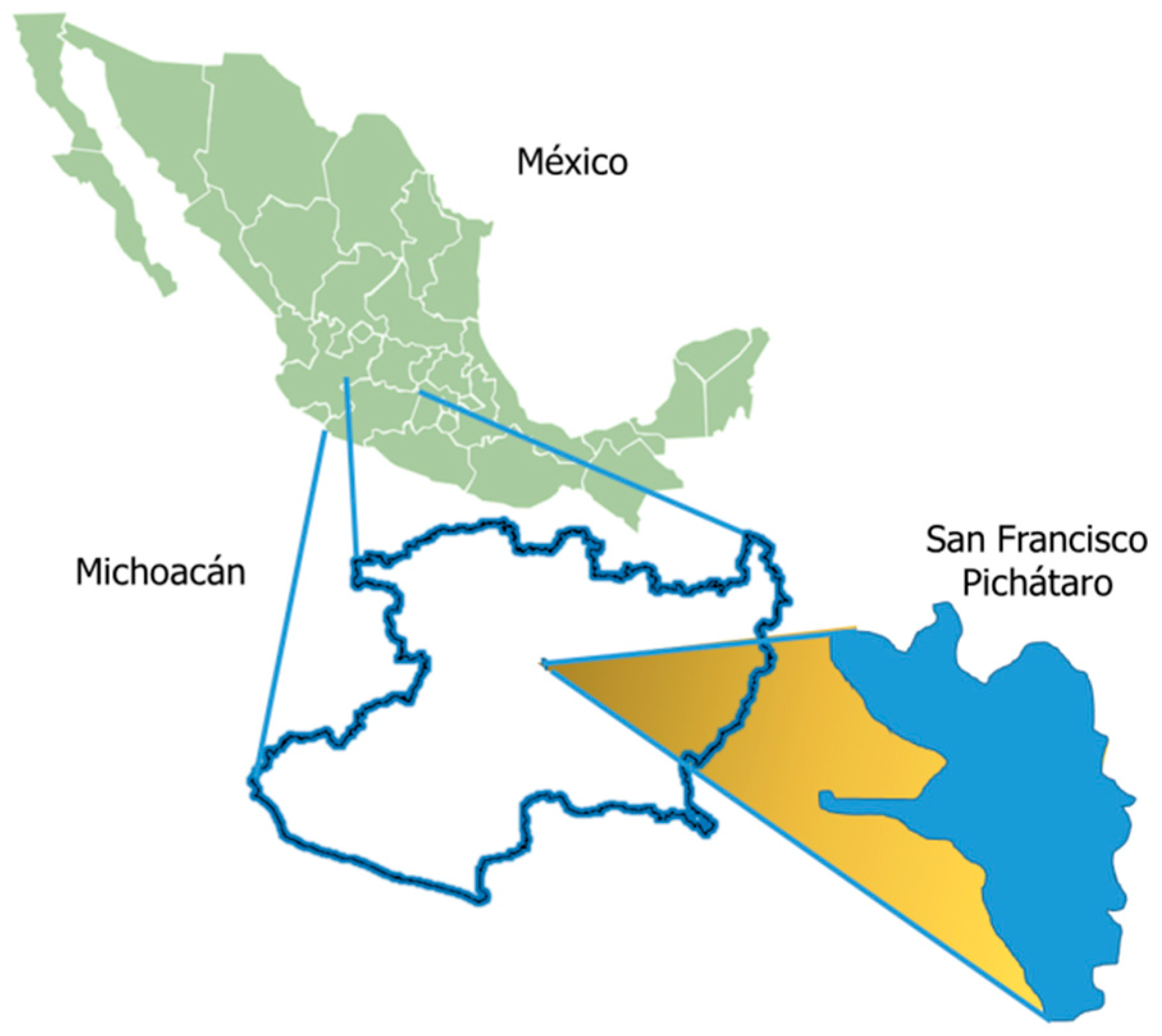
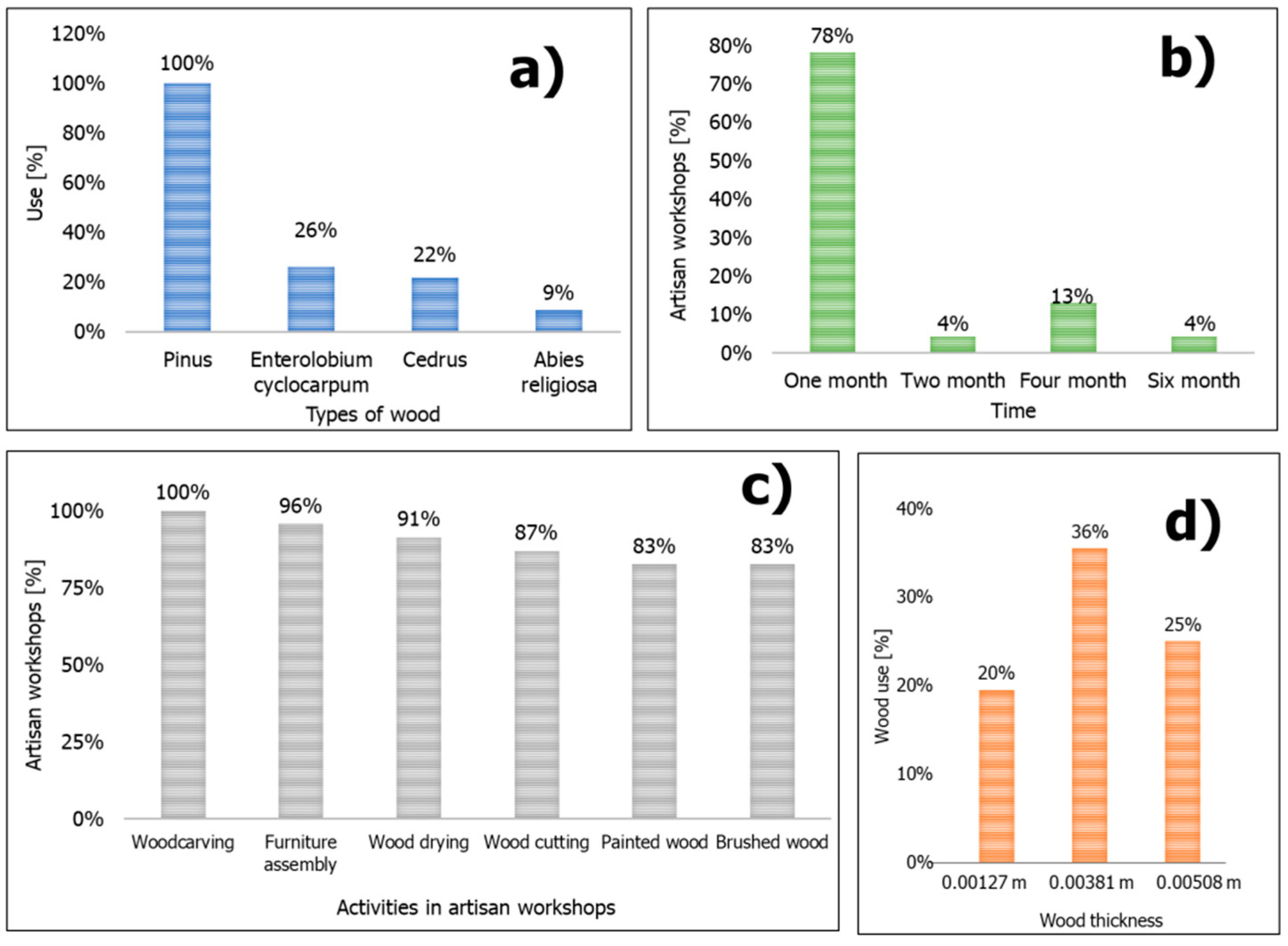
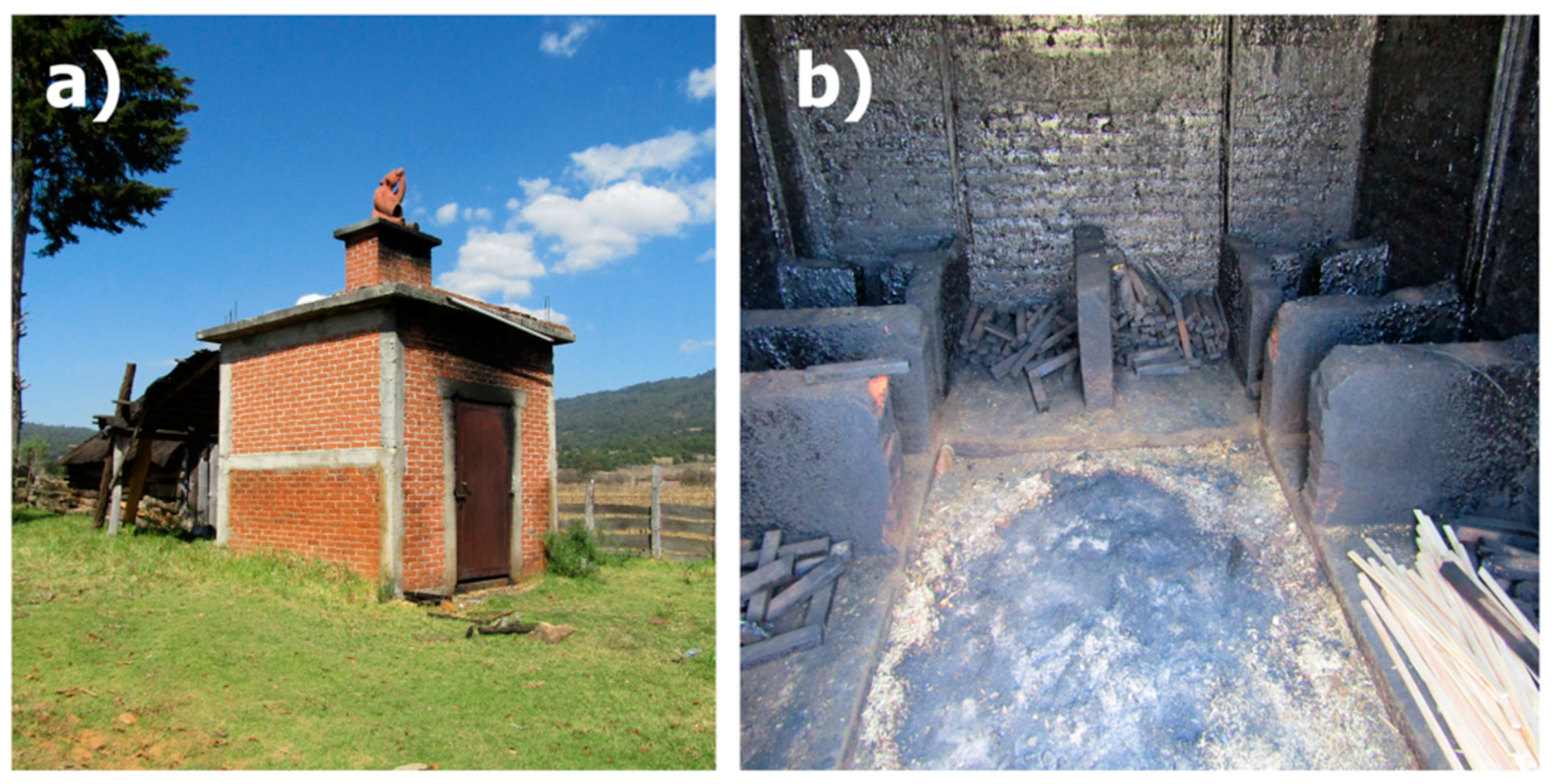
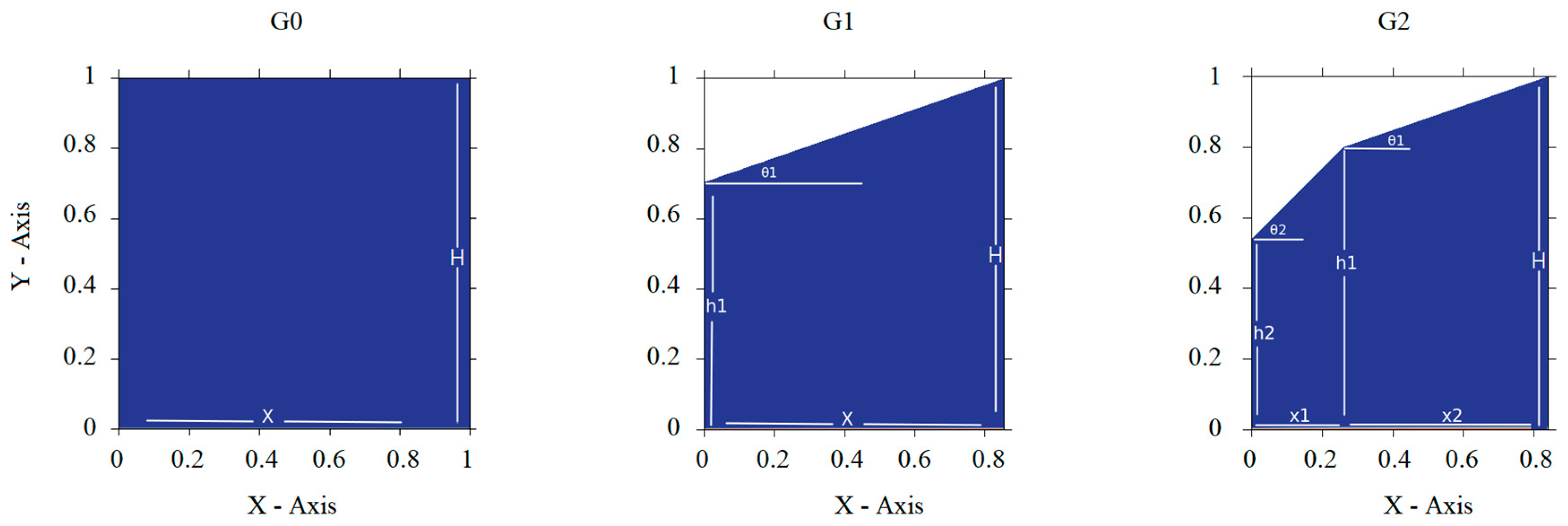
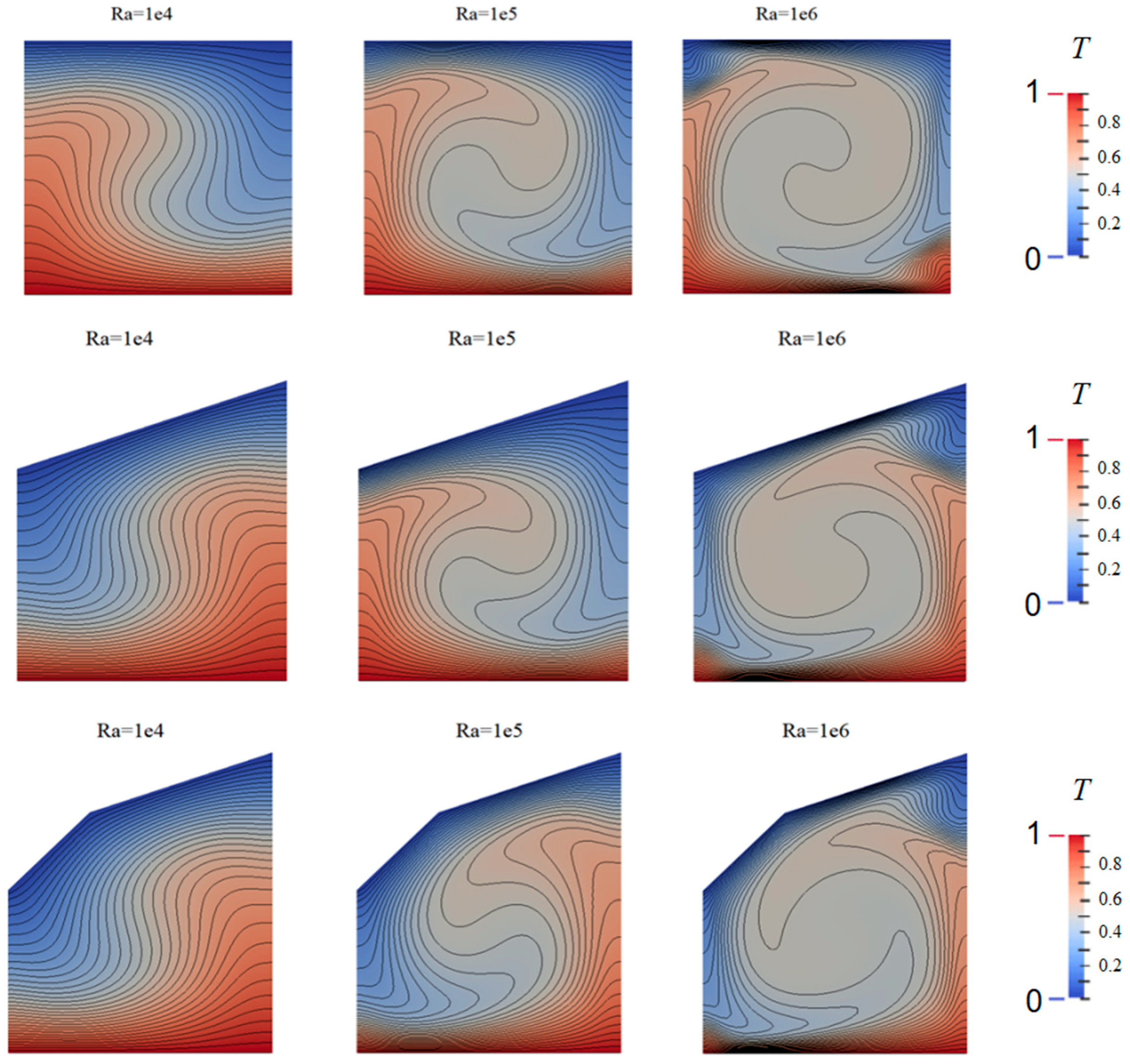
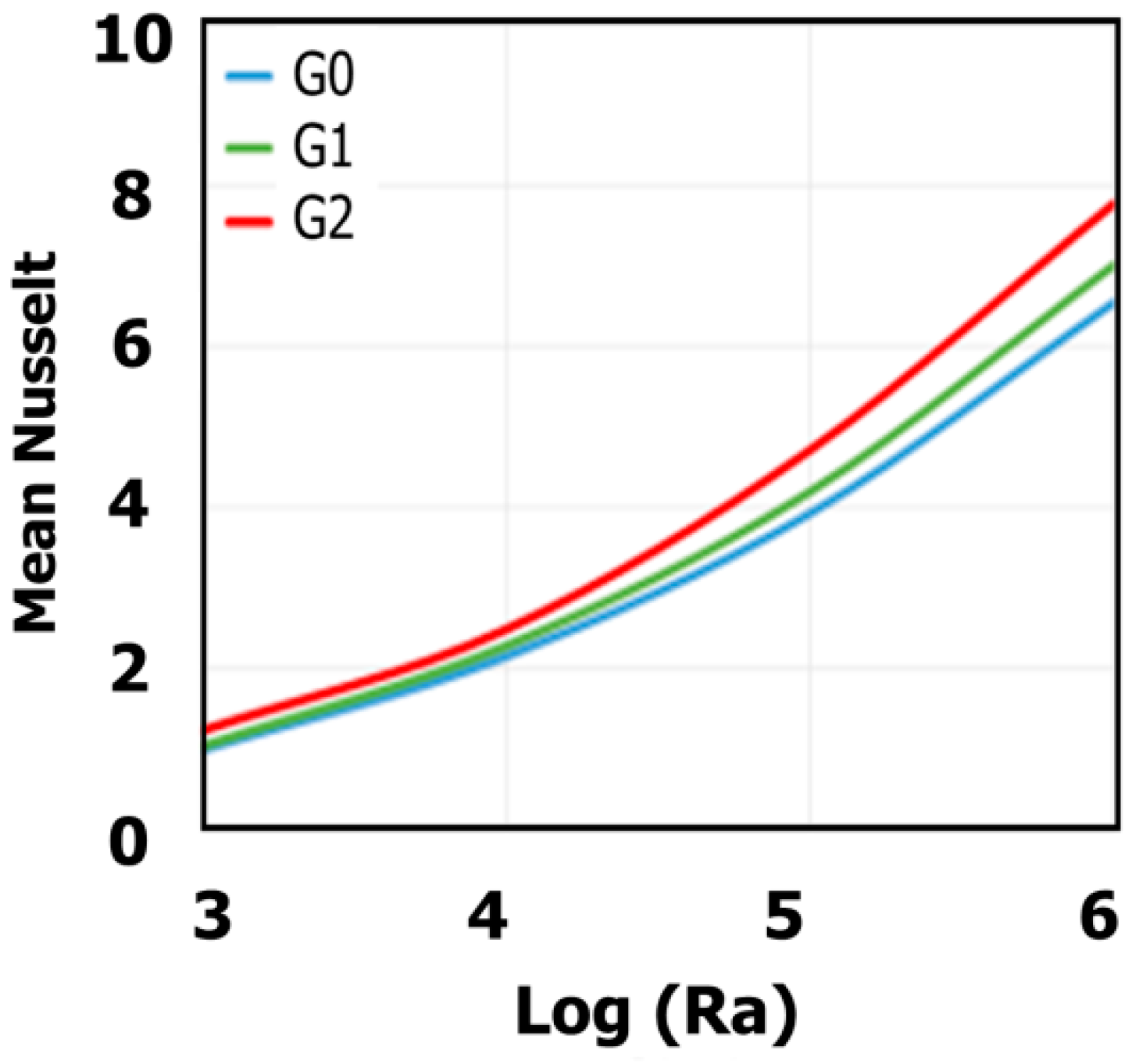
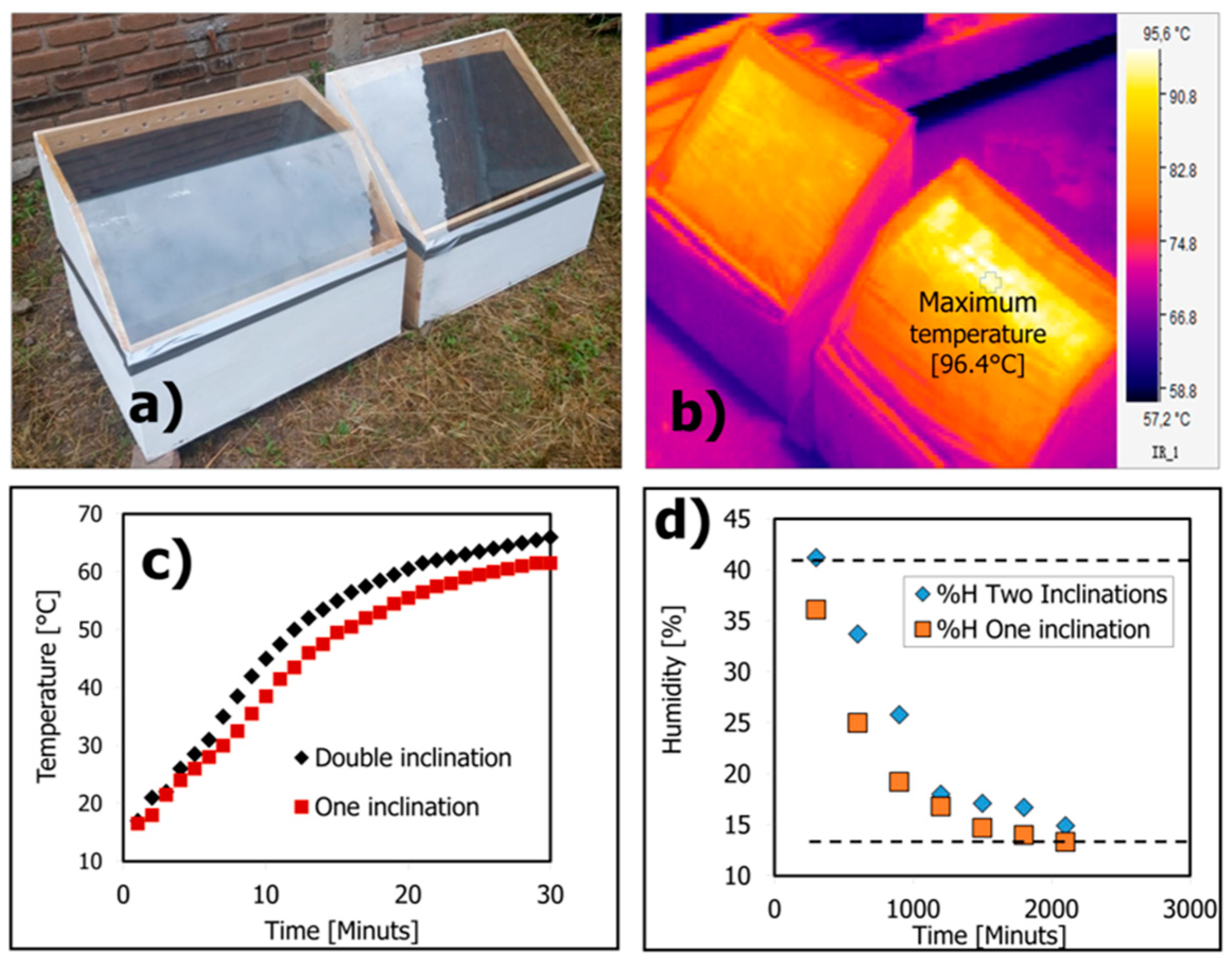
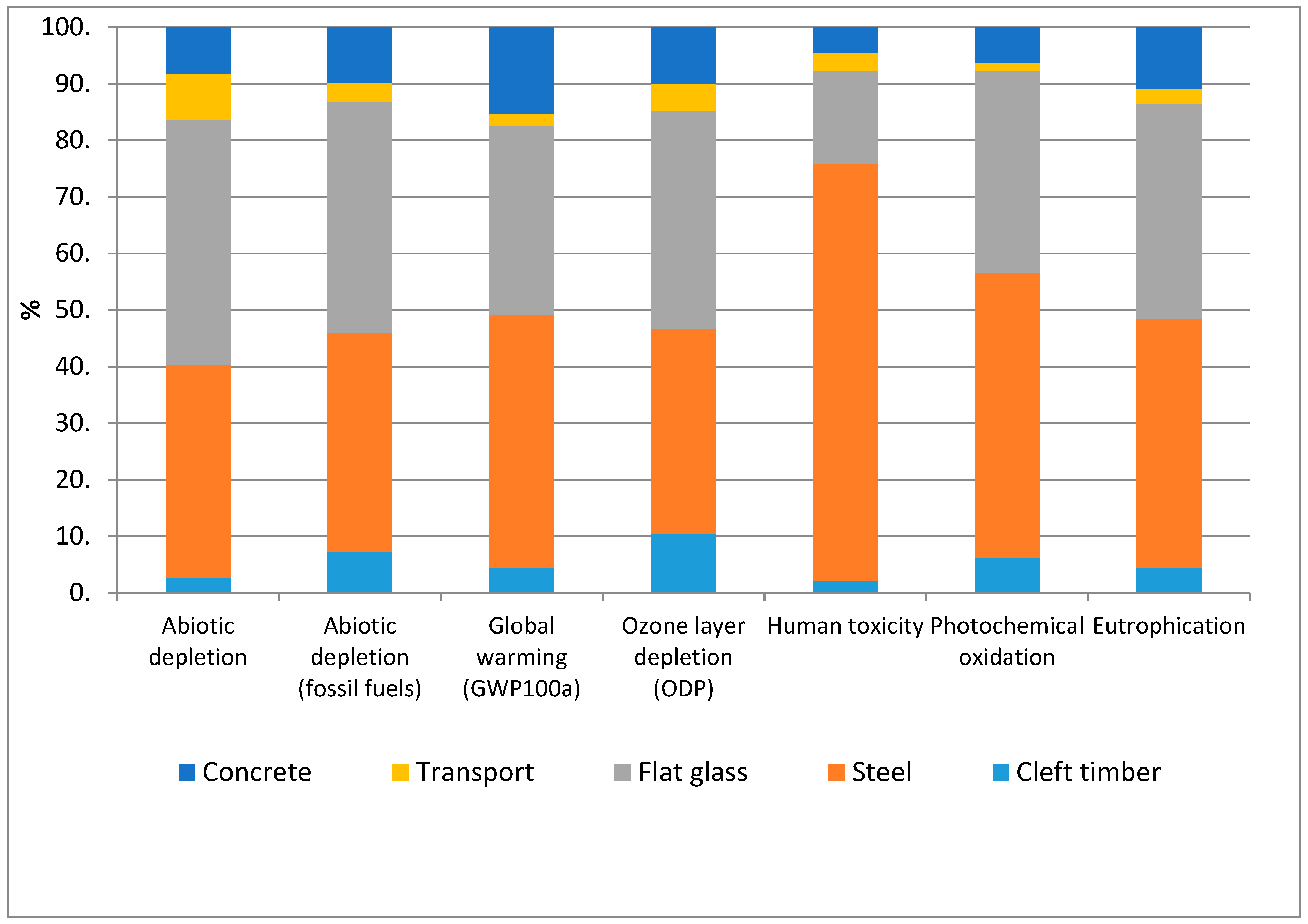
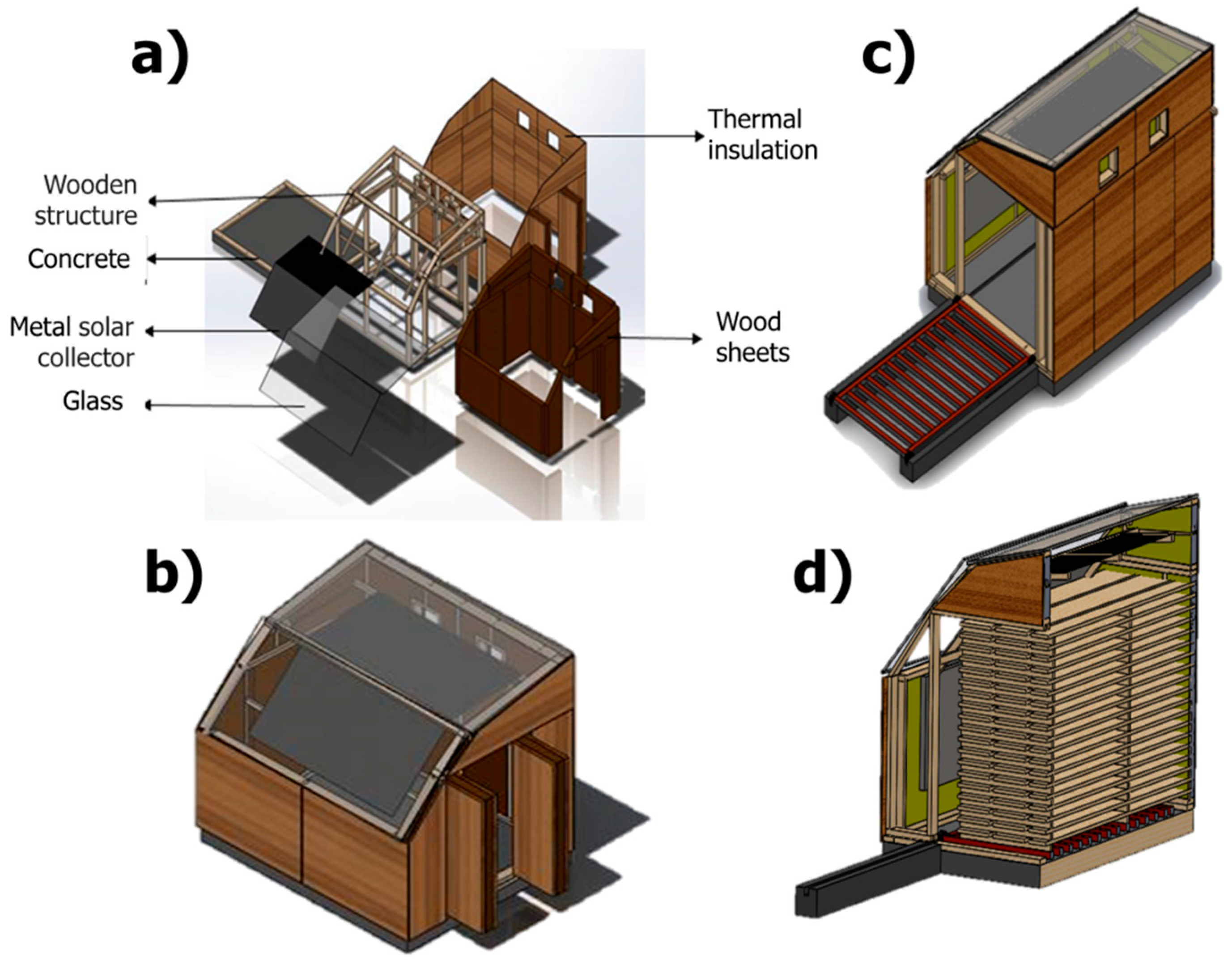
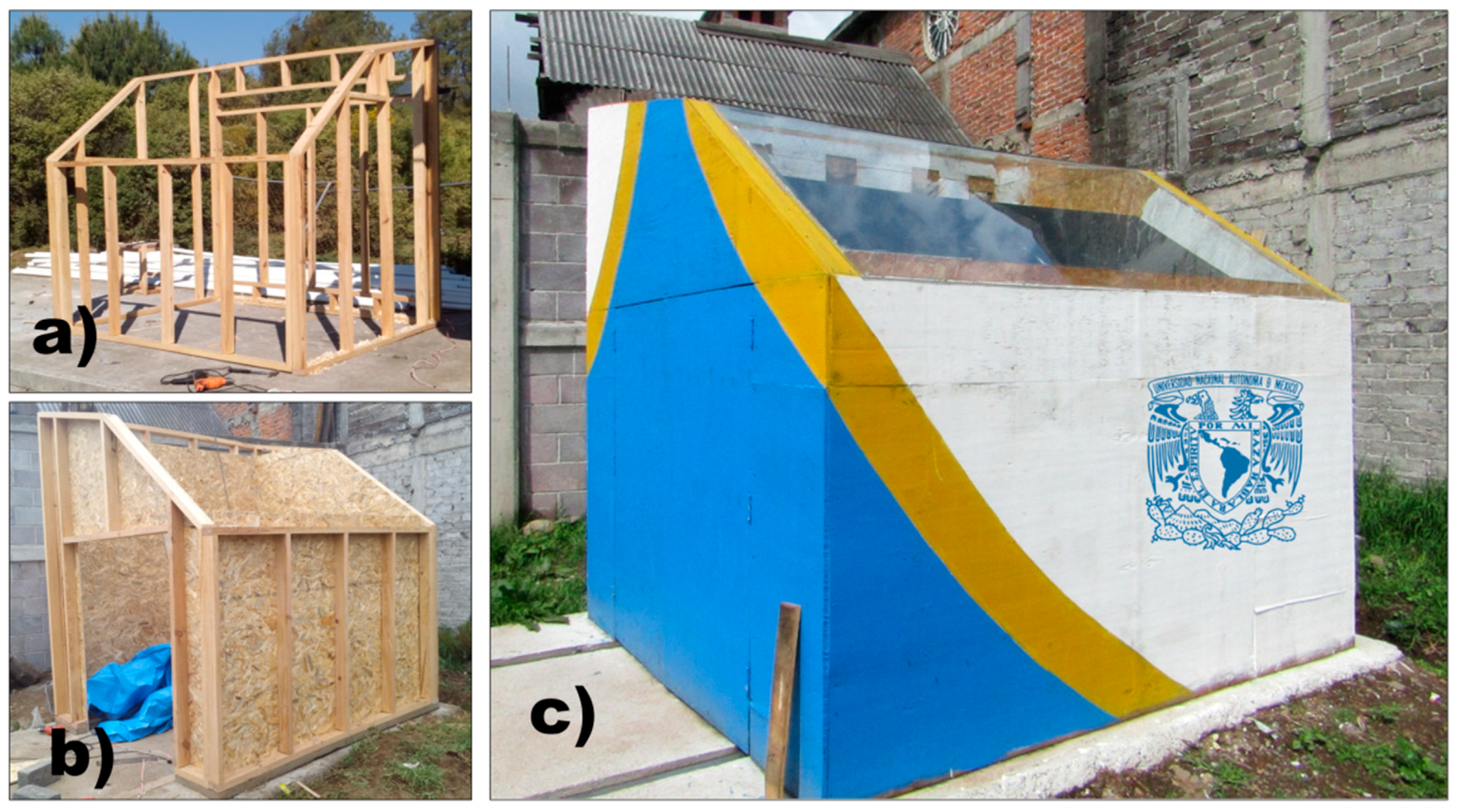
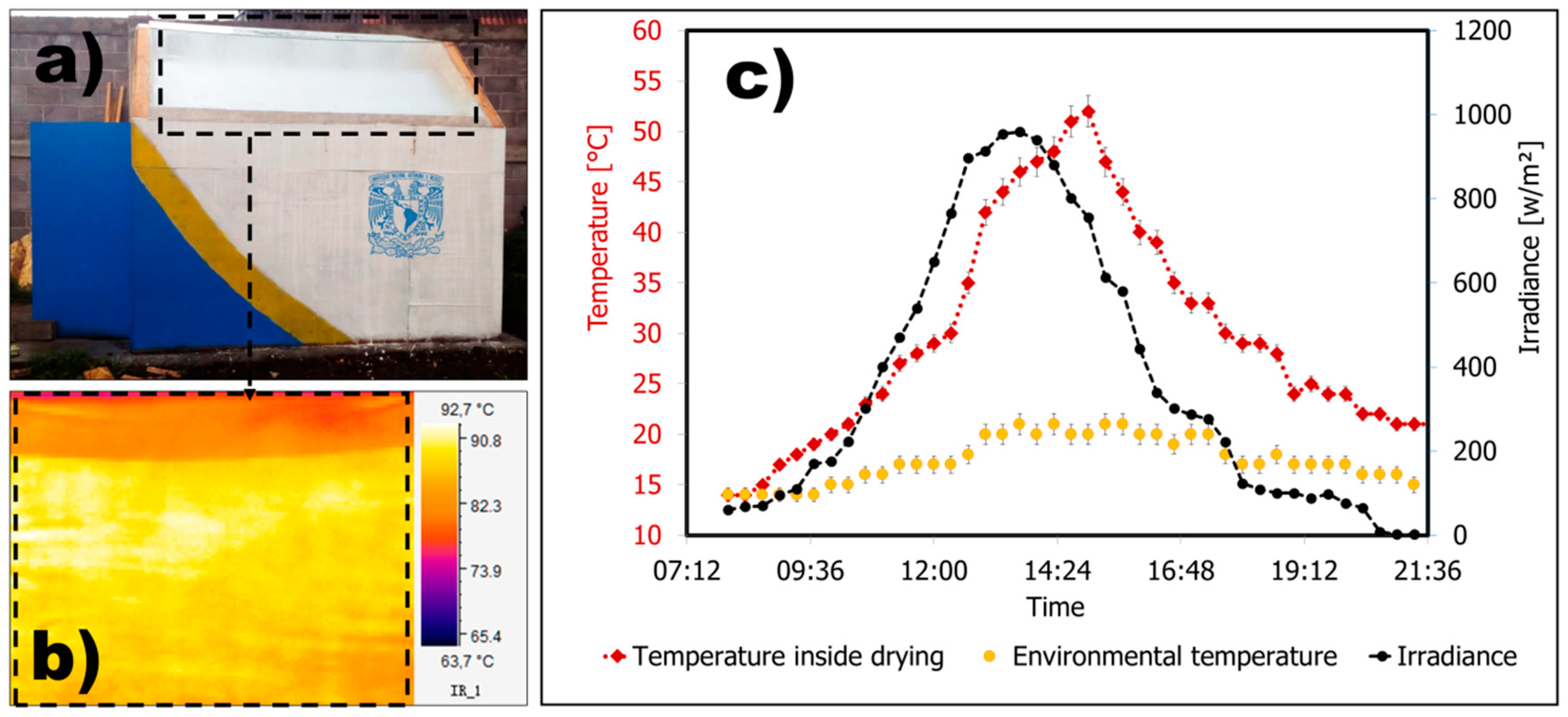
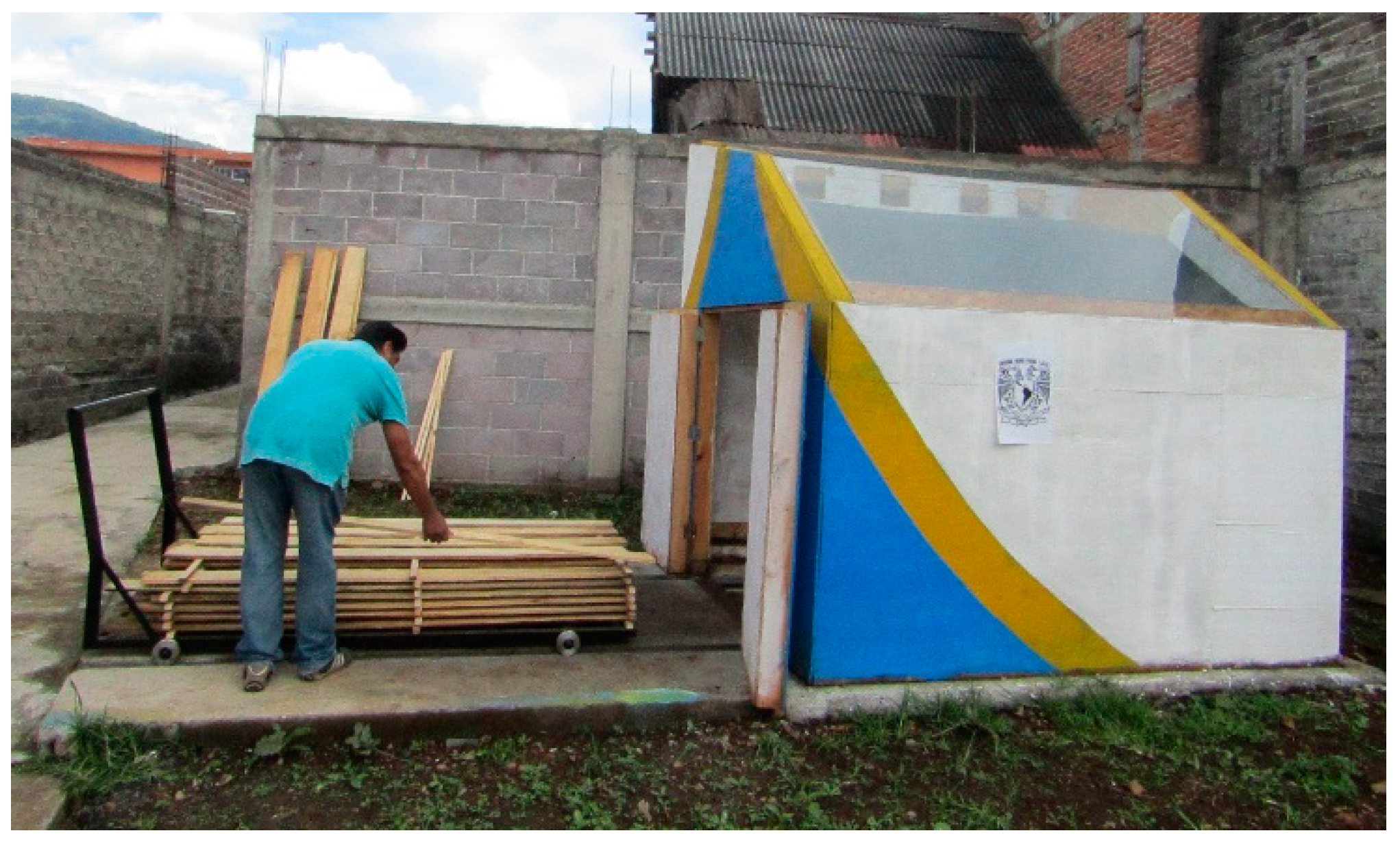

| Impact Category | Unit | Traditional Drier (Bricks and Cement) | Solar Dryer | % Impact Solar Dryer VS. Traditional Dryer |
|---|---|---|---|---|
| Abiotic depletion | kg Sb eq | 0.0635 | 0.0032 | 5% |
| Abiotic depletion (fossil fuels) | MJ | 385,322.7 | 8389.5 | 2% |
| Global warming (GWP100a) | kg CO2 eq | 36,451.5 | 899.0 | 2% |
| Ozone layer depletion (ODP) | kg CFC-11 eq | 0.00301 | 6.76E-05 | 2% |
| Human toxicity | kg 1,4-DB eq | 25,799.2 | 556.4 | 2% |
| Fresh water aquatic ecotox. | kg 1,4-DB eq | 12,303.8 | 195.2 | 2% |
| Marine aquatic ecotoxicity | kg 1,4-DB eq | 31,933,493.6 | 852,103.5 | 3% |
| Terrestrial ecotoxicity | kg 1,4-DB eq | 280.6 | −0.09 | −0.03% * |
| Photochemical oxidation | kg C2H4 eq | 90.7 | 0.3 | 0.31% |
| Acidification | kg SO2 eq | 410.3 | 2.6 | 1% |
| Eutrophication | kg PO4 eq | 148.7 | 0.9 | 1% |
| Concept | Traditional Dryer | Solar Wood-Dryer |
|---|---|---|
| Materials (USD) | 967 | 599 |
| Fuel (USD/m3 DM) | 0/22.1 ** | 0 |
| Dried Wood capacity—(m3 DM)/year * | 32 | 12 |
© 2019 by the authors. Licensee MDPI, Basel, Switzerland. This article is an open access article distributed under the terms and conditions of the Creative Commons Attribution (CC BY) license (http://creativecommons.org/licenses/by/4.0/).
Share and Cite
López-Sosa, L.B.; Núñez-González, J.; Beltrán, A.; Morales-Máximo, M.; Morales-Sánchez, M.; Serrano-Medrano, M.; García, C.A. A New Methodology for the Development of Appropriate Technology: A Case Study for the Development of a Wood Solar Dryer. Sustainability 2019, 11, 5620. https://doi.org/10.3390/su11205620
López-Sosa LB, Núñez-González J, Beltrán A, Morales-Máximo M, Morales-Sánchez M, Serrano-Medrano M, García CA. A New Methodology for the Development of Appropriate Technology: A Case Study for the Development of a Wood Solar Dryer. Sustainability. 2019; 11(20):5620. https://doi.org/10.3390/su11205620
Chicago/Turabian StyleLópez-Sosa, Luis Bernardo, José Núñez-González, Alberto Beltrán, Mario Morales-Máximo, Mario Morales-Sánchez, Montserrat Serrano-Medrano, and Carlos A. García. 2019. "A New Methodology for the Development of Appropriate Technology: A Case Study for the Development of a Wood Solar Dryer" Sustainability 11, no. 20: 5620. https://doi.org/10.3390/su11205620
APA StyleLópez-Sosa, L. B., Núñez-González, J., Beltrán, A., Morales-Máximo, M., Morales-Sánchez, M., Serrano-Medrano, M., & García, C. A. (2019). A New Methodology for the Development of Appropriate Technology: A Case Study for the Development of a Wood Solar Dryer. Sustainability, 11(20), 5620. https://doi.org/10.3390/su11205620






